Amy Myers's Blog, page 60
March 25, 2018
How to Use Hyperbaric Therapy for Autoimmune Conditions


Have you heard of hyperbaric oxygen therapy? Although it’s getting more and more attention in the health space and becoming increasingly available (I even have a hyperbaric chamber in my home!), it’s a relatively little known therapy. However, I have found it to be incredibly helpful, both personally and with some of my more complex autoimmune patients. In fact, I literally treated an autoimmune patient who was wheelchair bound because her muscles were so weak, and after 20 sessions of hyperbaric therapy she was able to walk again.
If you are dealing with an autoimmune condition and have seen great improvement with the diet and lifestyle changes on The Myers Way®, yet have hit a plateau or your symptoms haven’t fully resolved, there are a number of tools and treatments that I look to next, and hyperbaric therapy is one of them.
Hyperbaric therapy can be a powerful tool for numerous chronic health conditions including autoimmune disease, neurodegenerative conditions, autism, traumatic brain injuries, and more, because it helps reduce inflammation, heal infections, and repair damaged tissues. And as more people have discovered its powerful health benefits, hyperbaric oxygen therapy treatment centers have begun popping up just like cryotherapy and infrared sauna centers.
In this article I’ll walk you through what hyperbaric therapy is, its health benefits, and why I recommend it to certain autoimmune patients.
What is Hyperbaric Oxygen Therapy?
Hyperbaric Oxygen Therapy is the use of a special pressurized chamber to treat wounds, diseases and illnesses. Before it gained popularity, hyperbaric oxygen therapy was only available as a specialized treatment for people with the bends or decompression sickness (what scuba divers get when they resurface too quickly from the high-pressure deep under the sea to the much lower atmospheric pressure above water) or those with severe wounds.
The increased pressure inside the chamber allows extra oxygen into your body. The air we breathe contains 21% oxygen. The air inside one these chambers is 100% oxygen, and it has an atmospheric pressure two to three times greater than normal. As that oxygen reaches blood plasma, spinal fluid, bone marrow and tissues of the body, it has a healing effect.
There are 3 types of Hyperbaric oxygen therapy chambers:
Monoplace chamber – One patient at a time lies inside a clear tube breathing 100% medical grade oxygen at a specific atmospheric pressure for a designated amount of time. A specially trained hyperbaric technician monitors from outside the chamber. This is what you will find at most standalone hyperbaric therapy centers that are popping up.
Multiplace chamber – More than one patient may sit in chairs or recline while receiving oxygen through face masks or hoods. A hyperbaric technician accompanies patients into the chamber to monitor them directly. This is the type that is typically being used in hospitals.
Soft hyperbaric chambers – Otherwise known as mild hyperbaric chambers, these are “bags” made of polyurethane or canvas material. These chambers are less expensive and easier for people to use at home. These chambers do not have 100% oxygen like the other two hard-sided chambers. They are only able to increase atmospheric pressure, so may not have the same healing impact. This is the variety that I have in my home and what you may find at your physician or chiropractor’s office, or gym.
What Conditions Can Hyperbaric Therapy be Helpful for?
The Federal Drug Administration (FDA) has approved 13 medical conditions for hyperbaric therapy that can be covered by insurance. The ones approved by the FDA include:
Air or gas embolism
Carbon monoxide poisoning and carbon monoxide poisoning complicated by cyanide poisoning
Gas Gangrene – Clostridial myositis and myonecrosis
Crush injury – compartment syndrome, and other acute traumatic ischemias
Decompression sickness (The Bends)
Enhanced healing of selected problem wounds
Anemia – Severe blood loss from wound or severe trauma
Non-healing Wounds – Necrotizing soft tissue infections
Osteomyelitis (refractory)
Delayed radiation injury (soft tissue and bony necrosis)
Skin grafts and flaps (compromised)
Thermal burns
Intracranial abscess
However, there have been many studies done showing hyperbaric therapy can be used to treat a variety of conditions beyond this list. By raising oxygen levels in tissues where they have been lowered due to illness or injury, encouraging blood vessel growth, reducing swelling, and supporting your immune system, hyperbaric therapy can be helpful for a number of chronic conditions. Health practitioners throughout the world are successfully using this therapy every day to treat these “off-label” conditions.
Neurological Conditions and Brain Injuries
Hyperbaric therapy can improve oxygenation, new blood cell formation, and regenerative nerve growth in the brain, which is why it is a popular therapy among patients with dementia, Alzheimer’s, strokes, and traumatic brain injuries.
A study in 2009 also saw significant results in a clinical trial of hyperbaric therapy sessions with autism patients.1 The study found that autistic children who underwent the hyperbaric therapy saw marked improvements in receptive language, eye contact, social interactions, and sensory awareness compared to patients who did not.
Infections, Including Lyme Disease
Hyperbaric therapy is an established treatment for infections because it helps support your body’s natural defense mechanisms and can be particularly helpful for complex infections such as Lyme disease that are difficult to treat and can occur with co-infections. Lyme in particular is caused by a bacteria that thrives in a low oxygen state, so increasing your oxygen levels helps kill off the bacteria.
Mycotoxin or Toxic Mold Exposure
Because mold and mycotoxin exposure can lead to Chronic Inflammatory Response Syndrome (CIRS) in those who are genetically predisposed, hyperbaric therapy’s reparative and anti-inflammatory benefits are often utilized during mold treatment. And a study found that patients with mycotoxin exposure who were treated with hyperbaric therapy saw improvements in cognitive function.2
I used hyperbaric therapy when I became seriously ill from mycotoxin exposure while writing The Thyroid Connection, and it was a significant part of the puzzle in my recovery journey.
Autoimmune Disease
Of course, hyperbaric oxygen therapy can also be incredibly helpful for autoimmune diseases. Research shows success in treating patients with rheumatoid arthritis,3 scleroderma,4 Crohn’s disease,5 Raynaud’s,6 diabetes, lupus,7 and MS.8 I have also seen this evidence in my own clinic.
As I mentioned, I recommended it to one of my patients with a painful degenerative autoimmune condition who had seen great improvement after following my Autoimmune Solution Program but was still so weak that she relied on a wheelchair to get around. After 20 sessions of hyperbaric therapy she was able to walk tall into her next appointment. Her transformation was so powerful I get goosebumps just thinking about it!
Another of my patients had really severe psoriasis that had greatly improved though hadn’t fully resolved after treating her Candida overgrowth and optimizing her diet. She too underwent 20 hyperbaric treatments and her psoriasis completely disappeared.
Let’s take a look at why hyperbaric therapy can be such a great tool for those with autoimmunity.
How Hyperbaric Therapy is Helpful for Autoimmune Diseases
1. Reduces Inflammation
It’s important to remember, no matter what autoimmune condition is being treated or which tissues are affected, they are all diseases of the immune system. Your symptoms are a result of inflammation your immune system is creating in your body. Inflammation is an important part of your body’s natural reaction to injury and infection. However, in the case of autoimmunity, the inflammation has become chronic.
This chronic inflammation is a result of many factors, including leaky gut, an inflammatory diet, chronic stress, infections, and the toxins we are all exposed to on a regular basis. To treat, prevent, and reverse your autoimmune disease, you need to get your immune system and this ongoing inflammation under control. Hyperbaric oxygen therapy can be a powerful tool to reduce inflammation in your body.
Studies show hyperbaric oxygen has a greater anti-inflammatory effect than steroids! Hyperbaric therapy drives increased levels of oxygen into the bloodstream which travels through the plasma, resulting in reduced inflammation and pain. Studies show c-reactive protein and high levels of cytokines, both markers of chronic inflammation, can significantly decrease with hyperbaric therapy.9
2. Kills Infections
Hyperbaric therapy is an accepted, well-established treatment for serious infections,10 and healing infections is an important part of the Autoimmune Solution protocol. Harmful microbes, such as bacteria, viruses, parasites and fungus can be contributors to your body’s autoimmune response. Hyperbaric therapy can be particularly effective for infections of anaerobic microbes that cannot survive in active oxygen.
Hyperbaric therapy is also thought to improve the function of leukocytes, a type of white blood cell. The increased oxygen supply increases their ability to remove bacteria and debris from your body. White blood cells are major players in your body’s immune response, and an increase of oxygen actually stimulates the production of more white blood cells. This is good news if you are fighting infection.
3. Repairs Damaged Tissue
We know that with autoimmune disease our body is mistakenly attacking our own tissues. It could be the tissues of the thyroid gland, connective tissue, joints or nearly any part of your body. The wonderful thing about oxygen is that it can aid in the repair of these damaged tissues.
Over time, the combination of increased oxygen and increased pressure can help undo the damage to tissues and organ function. hyperbaric therapy saturates the blood plasma with oxygen, which, in turn, reaches the areas of damage with greater efficiency, providing cells and tissues with the oxygen needed for repair.
Hyperbaric therapy also enhances the growth of new blood vessels. Vital to the healing process, blood vessels carry the blood containing the cells and nutrients that enable healing. Not only that, they also remove damaged cells, debris and foreign microorganisms from our body. Research shows hyperbaric therapy treatment significantly increases the number and actual size of blood vessels in damaged tissues and wounds.
Although hyperbaric therapy is not FDA-approved for autoimmune diseases, there are many facilities around the world that will treat “off-label” conditions such as these. You can even purchase your own hyperbaric therapy chamber to use at home as I did. The one I use and recommend is Oxyhealth (oxyhealth.com). There are so many incredible benefits, I even recommend using hyperbaric therapy for general health and wellness and prevention of disease. The Myers Way® programs are always your first step to overcoming chronic illness, however, recovery can be significantly enhanced by using a hyperbaric oxygen chamber.
The post How to Use Hyperbaric Therapy for Autoimmune Conditions appeared first on Amy Myers MD.
March 23, 2018
Toxin-Free Easter Eggs


Can you believe that Easter is just around the corner? Easter is a wonderful time for gathering the family together, sharing a warm meal and, of course, coloring Easter eggs!
The problem with so many commercial food dyes is that they’re full of toxic chemicals that you or your kids wouldn’t want to be handling. Even though my own daughter, Elle, is not quite old enough yet to help dye Easter eggs, it’s something we’re looking forward to in the future, and I know that for many of you, it’s a big part of your own family tradition.
That’s why I created these toxin-free egg dyes, made from real, whole fruits and vegetables, so you can enjoy this fun tradition with your children worry-free! Happy Easter!
Toxin-Free Easter Eggs
CourseSnack
ProtocolAutoimmune Solution (AIP), Candida Control & SIBO, Elimination Diet, Paleo, Thyroid Connection
Ingredients
Pink Dye
2cups
filtered water
1
beetpeeled and quartered
1Tbsp
vinegar
Yellow Dye
1cup
filtered water
1Tbsp
ground turmeric
1Tbsp
vinegar
Blue Dye
2cups
filtered water
1cup
purple cabbageshredded
1Tbsp
vinegar
Purple Dye
1cup
filtered water
1cup
blueberries
Green Dye
1cup
filtered water
2cups
spinach
Instructions
Pink Dye
In a saucepan, add water and beets. Bring to a boil until water becomes a deep red or until desired color is reached, about 15 minutes.
Remove from heat, remove beets, and let cool. Add 1 tablespoon of vinegar.
Yellow Dye
In a saucepan, add water and turmeric. Bring to a boil until water becomes a deep yellow or until desired color is reached, about 3 to 4 minutes.
Remove from heat and let cool. Add 1 tablespoon of vinegar.
Blue Dye
In a saucepan, add water and cabbage. Bring to a boil until water becomes a deep purple or until desired color is reached, about 10 to 15 minutes.
Remove from heat and let cool. Add 1 tablespoon of vinegar.
Purple Dye
In a blender, add water and blueberries. Blend until completely combined.
Pour mixture through a cheesecloth or fine sieve to have only liquid.
Green Dye
In a saucepan, add water and spinach. Bring to a boil for 2-3 minutes. Remove from heat and let cool.
Once cooled, pour ingredients from saucepan into a blender. Blend until completely combined.
Pour mixture through a cheesecloth or fine sieve to have only liquid.
Recipe Notes
Submerge eggs in dye for 30 minutes to overnight depending on how bright or deep you would like the color.
The post Toxin-Free Easter Eggs appeared first on Amy Myers MD.
March 19, 2018
Video: Ask Dr. Myers
I went live on my Facebook page to answer some of your most popular questions from The Myers Way® Community!
Learn if the keto diet is recommended if you have Graves’ disease, what to look out for on packages when buying meat, the best fats for autoimmune-friendly cooking, and which type of probiotic is right for you!
Resources I Mentioned:
Autoimmune Solution
Thyroid Connection
The Autoimmune Solution Cookbook
Glutathione
Paleo Protein
Collagen Protein
Multivitamin
Adrenal Support
Enzymes
Liver Support
Butcher Box
Vital Choice
Desert Farms Hump Fat
Gelatin
100 Billion Probiotic
30 Billion Probiotic
Essentials Kit
Primal Earth Probiotic
Infant Probiotic
Wellness Coaching
Calcium
Vitamin D + K2
The post Video: Ask Dr. Myers appeared first on Amy Myers MD.
9 Signs You Have a Leaky Gut


Did you know that if you’re dealing with symptoms ranging from seasonal allergies to brain fog to skin issues to hormone imbalances that the true source could be your gut? That’s because the gut truly is the gateway to health. It’s where nearly 80% of your immune system lives and where up to 95% of your serotonin (the primary neurotransmitter responsible for your mood) is produced. If your gut is healthy, chances are that you are in good health.
However, there’s a condition called leaky gut that can lead to a whole host of health problems and set you on the path to chronic illness. The symptoms caused by leaky gut go far beyond digestive issues. And thanks to our modern environment, leaky gut is much more common than you’d think. In fact, millions of people are struggling with leaky gut without even knowing it!
What is Leaky Gut?
Think of your gut as a drawbridge. Your gut is naturally semi-permeable to let teeny-tiny boats (micronutrients) pass through your intestinal tract and into your bloodstream. It’s how you absorb your food. Certain external factors, including food, infections, toxins, and stress, can break apart the tight junctions in your intestinal wall, leaving the drawbridge open. Once this happens, you have a leaky gut. When your gut is leaky, much larger boats that were never meant to get through (toxins, microbes, and undigested food particles) can escape into your bloodstream. Your immune system marks these “foreign invaders” as pathogens and attacks them. The immune response to these invaders can appear in the form of any of the nine signs you have a leaky gut, which are listed below.
9 Signs You Have a Leaky Gut
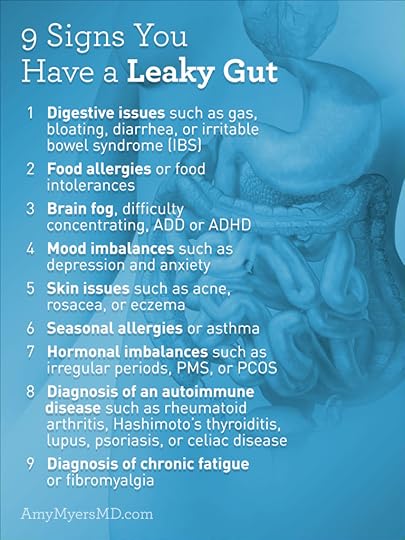
Digestive issues such as gas, bloating, diarrhea, or irritable bowel syndrome (IBS)
Food allergies or food intolerances
Brain fog, difficulty concentrating, ADD or ADHD
Mood imbalances such as depression and anxiety
Skin issues such as acne, rosacea, or eczema
Seasonal allergies or asthma
Hormonal imbalances such as irregular periods, PMS, or PCOS
Diagnosis of an autoimmune disease such as rheumatoid arthritis, Hashimoto’s thyroiditis, lupus, psoriasis, or celiac disease
Diagnosis of chronic fatigue or fibromyalgia
What Causes Leaky Gut?
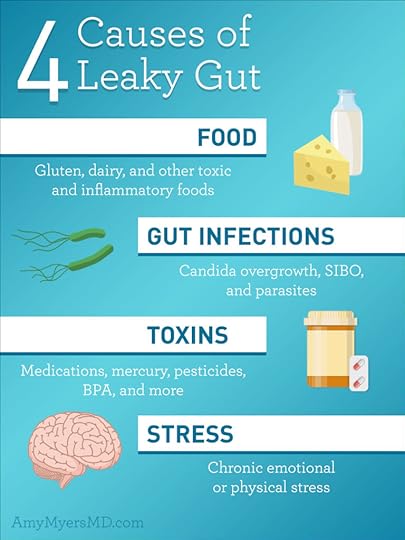
The main culprits are foods, infections, toxins, and stress. Gluten is the number one cause of leaky gut. Gluten causes the gut cells to release zonulin, a protein that can break apart the tight junctions in your intestinal lining. Other inflammatory foods (such as dairy) or toxic foods (such as sugar and excessive alcohol) are suspected as well. The most common infectious causes are candida overgrowth, intestinal parasites, and small intestine bacterial overgrowth (SIBO). Toxins come in the form of medications including NSAIDS (Motrin and Advil), steroids, antibiotics, and acid-reducing drugs, as well as environmental toxins including mercury, pesticides, and BPA from plastics. Stress can also contribute to a leaky gut.
The Leaky Gut and Autoimmune Connection
When your gut is leaky and more and more particles are able to escape into your bloodstream, your immune system reacts by sending out wave after wave of inflammation to attack the foreign invaders. This state of high alert causes your immune system to become overstressed and fire less accurately, sometimes leading your own tissues to get caught in the crosshairs. Eventually, this will develop into full-blown autoimmunity if your gut is not repaired.
In addition, your immune system starts making antibodies against the substances that have escaped into your bloodstream. Many of these foreign invaders–gluten and dairy in particular–look very similar to your own body’s cells, causing your immune system to get confused and accidentally attack your tissues. This process of mistaken identity is called molecular mimicry, and is another way that leaky gut can trigger autoimmune disease.
We know from the research of Dr. Alessio Fasano that leaky gut is a necessary precondition for developing an autoimmune disease.1 And, once you have an autoimmune disease, leaving your leaky gut untreated can cause your condition to progress and places you at higher risk of developing another autoimmune disease.
How Do You Repair a Leaky Gut?
In my clinic, and in all of my books and online programs, the very first place I have anyone start is by repairing their gut using the 4R approach, which is as follows:
Remove. Remove all inflammatory foods that can damage your gut such as gluten, dairy, corn, soy, and eggs, as well as toxic foods, including sugar, caffeine, and alcohol. You’ll also want to eliminate any gut infections you have, whether caused by Candida overgrowth, Small Intestinal Bacterial Overgrowth (SIBO), or parasites.
Replace. Replace the good. Adding digestive enzymes to your regimen will help support optimal digestion and nutrient absorption, as well as assist your body’s intestinal repair and inflammation responses.
Reinoculate. Restore the beneficial bacteria in your gut with high-quality, high-potency probiotics to reestablish a healthy microbiome. I recommend 100 billion CFUs (colony forming units) while dealing with a leaky gut, and 30 billion CFUs as a maintenance dose.
Repair. Provide your gut with the essential nutrients it needs to repair itself. L-glutamine is extremely beneficial for rejuvenating the gut wall lining. One of my other favorite supplements is collagen which is rich in amino acids that quite literally, “seal the leaks” or perforations in your gut by repairing damaged cells and building new tissue. You can get a free collagen when you spend $100 in the store now through Thursday, March 22nd at midnight CST! Just head to my store, add $100 of your favorite products to your cart, and then click “Checkout Now.” A box will pop up asking if you would like to add your free collagen, click “Add to Cart” and your bottle of collagen will be added for free!
Repairing your gut is the first step in restoring your health. By overcoming leaky gut, you can reverse your symptoms, reduce your risk for a number of chronic illnesses, and start living your best life!
The post 9 Signs You Have a Leaky Gut appeared first on Amy Myers MD.
March 18, 2018
5 Steps to Reverse Lupus


Systemic Lupus Erythematosus (SLE or lupus) is an autoimmune disease that can affect multiple systems of the body. This debilitating and sometimes life-threatening condition affects an estimated 5 million people worldwide and can involve the skin, joints, internal organs, and nervous system.1
As with all autoimmune conditions, lupus is a disease of the immune system. Your immune system has a very sophisticated mechanism for keeping you safe that it uses to identify the foreign substances that you come into contact with every day, such as allergens, toxins, infections, and even food. If your immune system deems anything dangerous, it will produce antibodies to ward off the harmful intruders.
Lupus occurs when your immune system does not successfully differentiate between the intruder and your own body. Mistaking your own tissues for foreign substances, your body turns these antibodies against itself, wreaking havoc on and destroying your organs.
Most autoimmune diseases affect one specific system. For example, Rheumatoid Arthritis involves the joints, and Multiple Sclerosis affects the brain and spinal cord. Lupus, on the other hand, affects more than one system simultaneously. No matter what organ or system is being attacked, all autoimmune diseases are similar in that they are an immune response caused by systemic inflammation that leads your body to attack itself.
By supporting, rather than suppressing, your immune system and restoring it to optimal function, you can reverse autoimmune conditions such as lupus and eliminate your symptoms.
Signs and Symptoms of Lupus
Symptoms of lupus vary widely and can range range from mild to severe, even life-threatening. Nicknamed “The Great Imitator,” lupus mimics other diseases because it impacts multiple bodily systems and symptoms often come and go, or change entirely.
The most common symptoms of lupus are:
Headaches
Fatigue
Fever
Joint pain and swelling
A butterfly-shaped rash across the nose and cheeks
Hair loss
Anemia
Ulcers in the nose and mouth
Edema (water retention) in the hands, feet, and face
Photosensitivity (sensitivity to light, especially sunlight)
Raynaud’s Disease (extremities turning white or blue when exposed to the cold)
How is Lupus Diagnosed?
Lupus is often missed or misdiagnosed because the symptoms are vague and can match those of other conditions. Generally, a doctor will review your medical history and your family history, and look for signs of systemic inflammation. Because lupus can involve the internal and external organs, a doctor will rely on observation as well as laboratory testing in order to make a lupus diagnosis. There is no one test for lupus–generally, many different criteria will need to come together, and it can take years to reach a diagnosis.
Conventional Treatment for Lupus
Conventional medicine is focused on managing the symptoms of lupus rather than finding the root cause. For this reason, treatment is based solely on medications. The first line of treatment for lupus is to prescribe drugs for specific symptoms, such as diuretics for fluid retention or aspirin for pain.
Next, a doctor will usually prescribe a corticosteroid such as prednisone, which has a variety of unpleasant and dangerous side effects. Long term prednisone therapy can cause muscle wasting and osteoporosis, and those side effects require additional monitoring and medication. If the steroids stop controlling the symptoms, then a host of other serious medications are prescribed that either modulate or suppress the immune system as a whole. Plaquenil and belimumab (Benlysta) are some of the drugs used, and they have very harsh side effects including hair loss, muscle atrophy, blood disorders and increased susceptibility to infections.
Conventional medicine does not look at the body as a whole, instead viewing it in terms of isolated systems, with a separate doctor for each one. Generally, lupus patients are under the care of a rheumatologist and a doctor who specializes in the area in which they are experiencing symptoms–for example, a nephrologist for your kidneys, and a dermatologist for your skin.
However, this type of “specialized” treatment ignores the reality that all of your bodily systems are interconnected. Functional medicine, on the other hand, looks at the health of the entire body based on the fact that the health of one organ affects the function of the others. Rather than simply treating the symptoms, functional medicine aims to get at the underlying root causes of disease.
5 Underlying Root Causes of Lupus
If you suspect that you have lupus, I recommend taking a functional medicine approach to uncover what caused your immune system to go rogue and attack your own tissues in the first place. Below are the top five underlying causes of lupus.
Leaky Gut:
Your gut is somewhat permeable to allow very small molecules (micronutrients) pass through the intestinal wall. It’s how you absorb your food. Many factors can damage your gut, including gluten, infections, medications and stress. This damage allows much larger particles such as toxins, microbes, and undigested food particles to “leak through” your gut and enter your bloodstream, triggering an immune response. We know from the research of Dr. Alessio Fasano that leaky gut is a necessary precursor to autoimmunity, meaning if you’re dealing with lupus, you also have a leaky gut. Not to mention, your gut is where nearly 80% of your immune system lives. So in order to overcome lupus, you must first repair your gut.
Gluten Intolerance:
Gluten is one of the leading causes of leaky gut and inflammation, and has been linked to more than 55 diseases.2 The majority of symptoms of gluten intolerance are not digestive in nature–rather, they appear as neurological issues such as pain, cognitive impairment, sleep disturbances, behavioral issues, fatigue and depression.
Gluten can also lead to what’s known as molecular mimicry. The gluten protein, gliadin, resembles many of your body’s own tissues, particularly thyroid tissue. If you have Celiac disease, gluten intolerance, or a leaky gut, your immune system releases gliadin antibodies every time you eat gluten. Because gliadin looks so similar to your own tissues, sometimes these antibodies mistakenly attack other organs and systems, from the skin to the thyroid to the brain. This case of mistaken identity often leads to full-blown autoimmune disease.
Toxins:
Toxic molds (mycotoxins) and heavy metals such as mercury are the two main toxins I see in those with autoimmune conditions. Mycotoxins are highly toxic substances produced by toxic molds. Only about 25% of the population carries the genes to be susceptible to the effects of mycotoxins.3 Conventional environmental mold testing only tests for levels of mold spores and does not test for mycotoxins. I use a urine mycotoxin test in my clinic to determine if someone has been exposed to toxic molds.
Mercury is toxic to our bodies and can be one piece of the puzzle for those with lupus and other chronic illnesses such as chronic fatigue syndrome, other autoimmune diseases, neurological disorders, and cancer. Mercury overload is far more common than many people think. We’re exposed to mercury in our air and water, the fish we eat, amalgam fillings, cosmetics, and vaccines. I recommend heavy metal testing for all of my patients with autoimmunity, using a pre- and post-DMPS urine challenge test. I also recommend that anyone with mercury amalgam fillings find a biological dentist and have them removed.
Infections
Scientists have suspected for years that infections from bacteria, viruses, and other toxins were likely to blame for the development of conditions like lupus. And while they have not been able to identify one single culprit, they have found strong correlations with a number of bacteria and viruses. For example, the Epstein-Barr virus (EBV) has been shown to trigger lupus in some individuals.4
Stress
Levels of stress-related illnesses are on the rise, and stress, both emotional and physical, has been shown to trigger and intensify autoimmune disorders. Stress is your body’s response to a threat–a wound, injury, or infection. Acute stress revs up your immune system to help you deal with an immediate crisis, and then calms it back down once the threat is removed. On the other hand, chronic stress (the kind we face in this day and age) leads to long-term inflammation and actually suppresses your immune system. This can trigger or worsen autoimmune conditions, and can lead to the reactivation of latent viruses linked to lupus, perpetuating a vicious cycle.
5 Steps to Reverse Lupus
1. Repair your gut
Because of the leaky gut autoimmune connection and the huge role your gut health plays in your immune system, repairing your gut is the very first place to begin in reversing any type of autoimmune condition. I use the 4R approach to repairing the gut with my patients, and in all of my books and programs.
Remove. Remove the bad. The goal is to get rid of factors that negatively affect the environment of the GI tract, including inflammatory foods such as gluten, dairy, corn, soy, and eggs, as well as toxic foods, including sugar, caffeine, and alcohol. Finally you’ll want to eliminate gut infections from Candida overgrowth, Small Intestinal Bacterial Overgrowth (SIBO), and parasites.
Replace. Replace the good. Add back the digestive enzymes required for proper digestion.
Reinoculate. It’s critical to restore beneficial bacteria to reestablish a healthy microbial balance in your gut. High-quality, high-concentration, probiotics can help repair your gut and strengthen your immune system. I recommend 100 billion CFUs (colony forming units) while dealing with a leaky gut, and 30 billion CFUs as a maintenance dose.
Repair. It’s essential to provide the nutrients necessary to help the gut repair itself. One of my favorite supplements is collagen which is rich in amino acids that quite literally, “seal the leaks” or perforations in your gut by repairing damaged cells and building new tissue. Another one of my favorites supplements is L-glutamine, an amino acid that helps to rejuvenate the gut wall lining.
2. Optimize your diet
I recommend that everyone remove gluten from their diets because it’s simply an inflammatory food, and this is particularly critical for anyone with an autoimmune condition. I also highly recommend that anyone with an autoimmune condition remove all grains and legumes from your diet as well. These foods contain proteins known as lectins, which act as a natural pesticide for crops and can wreak havoc on the lining of your gut. My cookbook, The Autoimmune Solution Cookbook, contains over 150 specially designed recipes to help make following an autoimmune-friendly protocol easy and delicious!
3. Find and treat infections
Have your doctor test for infections such as herpes simplex virus (HSV) and EBV. Monolaurin from coconut oil can be very effective treatment for both HSV and EBV. Lysine and a lysine-rich diet is effective at treating HSV infections.
4. Test for heavy metals and mycotoxins
I recommend having your MTHFR genes tested, as this genetic mutation can impact how you detoxify mercury and other heavy metals. There are multiple options for heavy metal testing, however I’ve found the DMPS “challenge” test to be the gold standard. To assess whether someone is being exposed to mycotoxins, I use the test from Real Time Lab. If either heavy metals or mycotoxins are an issue for you, work on minimizing your exposure to these toxins, and be sure to support your detox pathways while you work to flush them out.
5. Relieve your stress
I believe that we should ALL benefit from regularly working on stress relief! Take care of yourself by adopting stress-relieving strategies, such as exercise, meditation, yoga, art, or whatever works for you. The key is to choose something that you will enjoy and stick with. I personally use a heart rhythm pacer called InnerBalance, an app that coaches you to breathe in line with your heartbeat. Even giving yourself five minutes to sit quietly with a fragrant cup of herbal tea (caffeine-free, of course!) can work wonders for your adrenal glands.
Whether you’re dealing with lupus, rheumatoid arthritis, Hashimoto’s or one of the hundreds of other autoimmune conditions out there, you have the power to beat your symptoms, regain your energy, and feel like yourself again. By following these steps to uncover the root cause of your illness, you CAN reverse your disease and live a life full of optimal health!
Ready to get started? The Myers Way® Autoimmune Solution Program will show you how to make the necessary dietary and lifestyle changes to support your immune system, achieve your goals, and take back your health.
The post 5 Steps to Reverse Lupus appeared first on Amy Myers MD.
March 16, 2018
Chimichurri Cauliflower Steaks


Whether you’re a vegetarian or just looking for a simple, meat-free dish to add to your weeknight dinner rotation, you need to try these Chimichurri Cauliflower Steaks!
These “steaks” are so hearty, you can serve them as a main dish–or split them into smaller portions to serve on the side.
The chimichurri sauce lends a fresh brightness to the rustic flavor of the roasted cauliflower, and you can whip it up while your steaks cook!
Enjoy!
Chimichurri Cauliflower Steaks
CourseMain Dish, Side Dish
ProtocolAutoimmune Solution (AIP), Candida Control & SIBO, Elimination Diet, Paleo, Thyroid Connection
Servings2 people
Ingredients
Cauliflower Steaks
1large head
cauliflower florets
3Tbsp
avocado oil
1/2tsp
ground turmeric
fine sea saltto taste
ground black pepperto taste
Chimichurri Sauce
1cup
cilantrochopped
1/4cup
shallotchopped
1/4cup
olive oil
1/4cup
apple cider vinegar
1Tbsp
lemon juice
3cloves
garlicchopped
1/4tsp
salt
Instructions
Preheat the oven to 400 F. Line a sheet pan with parchment paper.
Remove leaves and base stem from cauliflower. Slice into ½ inch “steaks”. Extra cauliflower florets can be cooked as well or set aside for other recipes.
Lay cauliflower steaks on sheet pan. Brush on each side with avocado oil. Season with salt, pepper, and turmeric. Place in oven and roast about 15 minutes or until lightly browned.
While the cauliflower cooks, prepare chimichurri by placing all ingredients into the bowl of a food processor or blender and pulse until blended but not fully runny.
Remove cauliflower from oven and serve on plates. Top with chimichurri sauce. Reserve extra chimichurri for later use with meals.
The post Chimichurri Cauliflower Steaks appeared first on Amy Myers MD.
March 15, 2018
Should You Try a Keto Diet if You Have Hashimoto’s?


Ketogenic (or “keto”) diets are all the rage right now. Along with helping you lose weight and increase your energy levels, keto diets have the potential to reverse a number of chronic illnesses, from diabetes, to cancer, and even certain autoimmune diseases. For this reason, you may be wondering if you should try a keto diet if you have Hashimoto’s.
While everyone reacts differently to keto diets–or any diet for that matter–there are a few key factors to consider before jumping on the keto bandwagon if you have Hashimoto’s or any other autoimmune thyroid condition.
The Keto Diet and Hashimoto’s
What is the Keto Diet?
The keto diet is a very low-carb diet that emphasizes high fat intake and includes moderate amounts of protein. Carbohydrates on a “true” keto diet are restricted to roughly 5% of your daily calories (about 20-30g), compared to a standard diet that gets 45-60% (225-325g) of daily calories from carbs.
Your body’s main source of fuel is glucose, which comes from carbohydrates. However, when you replace the carbs in your diet with lots of healthy fats, your body enters a metabolic state known as “ketosis,” which burns stored fat for fuel instead of glucose.
Studies have shown that following a keto diet can support a healthy immune response and increase your body’s glutathione levels, which are notoriously low in people with autoimmunity.1 Although keto may be helpful for some autoimmune conditions, it might not be the best option when it comes to Hashimoto’s, and I explain why below.
The Effect of a Keto Diet on Thyroid Function
The problem with a keto diet if you have Hashimoto’s is that the parts of your brain that regulate thyroid hormones–the hypothalamus and the pituitary gland–require glucose to function.2 In fact, Thyroid Stimulating Hormone (TSH) is partly made up of glucose molecules. Severe carbohydrate restriction significantly reduces the amount of Free T3 (FT3) and increases Reverse T3 (RT3).3 When you have Hashimoto’s, your thyroid is already under-producing its hormones in a state known as hypothyroidism. Having too much RT3 and not enough FT3 can exacerbate hypothyroid symptoms.
For this reason, it’s best to proceed with caution if you have Hashimoto’s and wish to experiment with a keto diet. Another option is to try a “modified” keto diet, where you eat at least 50g of carbs per day. No adverse effects on thyroid hormone production were found at this level of carb intake.
The most important dietary change you should make if you have Hashimoto’s is to remove all toxic and inflammatory foods from your diet, especially gluten. I walk you through exactly how to optimize your diet for thyroid function, including a 28-day meal plan with specially designed (and delicious!) recipes, in my New York Times Bestseller, The Thyroid Connection.
How to Follow a Keto Diet if You Have an Autoimmune Disease
While it’s best to be cautious when making extreme dietary changes, I do want to emphasize that no two people are alike, especially when it comes to what we eat. You may find that even with Hashimoto’s, you do extremely well on a keto diet! Just be sure to consult with your doctor before making the transition, and monitor your thyroid levels closely while following a keto diet.
To learn more about the health benefits of keto, how to follow a keto diet if you have autoimmunity, and what supplements you can take to support yourself while on a keto diet, see my other article on this topic: Should You Try a Keto Diet if You Have an Autoimmune Disease?
The post Should You Try a Keto Diet if You Have Hashimoto’s? appeared first on Amy Myers MD.
Should You Try a Keto Diet if You Have Hypothyroidism?


The ketogenic (or “keto”) diet is one of the trendiest low-carb diets these days, emphasizing high-fat intake and very limited carbohydrates as compared to a standard diet or even a Paleo diet. Historically, the keto diet was developed as an alternative treatment for epileptic children, and has been proven to reduce the number of seizures in patients with epilepsy.1 It also shows promise for use in treating other chronic illnesses, including diabetes, Alzheimer’s, Parkinson’s, and cancer.2 Given its potential health benefits, you may be wondering if you should try a keto diet if you have hypothyroidism. Here’s what I recommend.
The Keto Diet and Hypothyroidism
What is Hypothyroidism?
Hypothyroidism, or having an underactive thyroid, is when your thyroid gland does not produce enough thyroid hormone. Thyroid hormones affect nearly every part of your body, including your metabolism, brain, heart, muscles and skin. Without enough thyroid hormone, all of your bodily processes slow down to a sluggish crawl. Women and those with autoimmune disease are more likely to have hypothyroidism.3
The Role Your Adrenals Play
Chronic stress can also lead to hypothyroidism. Your adrenals produce stress hormones, such as cortisol. When you experience stress, a cascade of stress hormones signals your body to slow down all processes that are unnecessary for overcoming the stressor in front of you, including thyroid hormone production.
In our modern society, many of us experience one stressor after another with no time in between to physically recover. Chronic stress overworks your adrenals, which are unable to keep up with the constant demand for more and more stress hormones, inevitably leaving you in a state of adrenal fatigue. This flooding and eventual plummeting of stress hormones causes your thyroid to come to a screeching halt.
Adrenal Fatigue and Ketosis
The goal of a keto diet is to achieve the metabolic state known as “ketosis.” Depriving your body of its main fuel source, glucose (which comes from carbs), triggers your body to burn stored fat for fuel instead. It is this fat-burning state of ketosis that is responsible for the rapid weight loss and enhanced energy and brain function that people typically experience on a keto diet.
However, ketosis can be a major strain on the adrenals. Reduced carb intake leads to a decrease in thyroid hormone levels and an increase in cortisol–which decreases thyroid function even further and means more work for your adrenals.4 If your adrenals are already fatigued, you do not want to stress them out even more by going into ketosis.
This vicious cycle is why you should proceed with caution when it comes to a keto diet if you are hypothyroid, particularly if adrenal fatigue is one of the primary causes of your hypothyroidism. For this reason, I would recommend avoiding a keto diet until you have addressed your stress levels.
How to Determine if a Keto Diet is Right for You
Everybody is different, so it’s important to listen to your body and know what you do or do not tolerate. You may do perfectly fine on a keto diet, or you might find your body doesn’t respond well to it. Either way, if you have hypothyroidism and are looking to experiment with a keto diet, be sure to consult your doctor first and monitor your thyroid levels closely during this time.
To learn more about whether a keto diet might be right for you, including the health benefits of a keto diet, how to follow a keto diet, and which supplements you can take to help support you while following a keto diet, see my article Should You Try a Keto Diet if You Have an Autoimmune Disease?
The post Should You Try a Keto Diet if You Have Hypothyroidism? appeared first on Amy Myers MD.
March 12, 2018
9 Tips to Adjust Your Sleep Cycle After Daylight Savings


Daylight Savings Time (DST) has begun, which means you lost an hour of sleep this weekend–and you’re likely already feeling the effects! You might be a little groggier in the morning or feel the need to take a nap as afternoon rolls around. Or perhaps your whole day has shifted, and you’re waking up and staying up later than usual. You may even feel hungrier and find yourself craving sugary foods to stay awake!1
Regular sleep is essential to the proper function and health of your entire body. It helps regulate your immune system, maintain optimal hormone balance (including ghrelin–the hunger hormone), enhance brain function, and support emotional well-being.2 Lack of sleep can raise your risk for some chronic health issues, including diabetes, heart disease, and obesity.3 A study conducted by the University of Colorado Boulder also found an increased risk of car crashes for the first six days of DST, showing how even minor disruptions in sleep schedules can be hazardous.4
For these reasons, it’s important to reset your sleep cycle as quickly as possible to ensure you’re operating at peak performance. I’ve compiled this list of tips on how to adjust your sleep cycle after Daylight Savings to help get you back into a healthy rhythm!
1. Stick to Your Normal Sleep/Wake Schedule
Your circadian rhythm is the 24-hour internal clock that is responsible for feelings of drowsiness or alertness throughout your day. Normally, your circadian rhythm coincides with the cycles of daytime and nighttime, and works best when you wake up and go to bed at the same time every day. When this gets thrown off by external factors such as Daylight Savings Time, jet lag, or late-night binge watching your favorite TV show, you’ll notice natural dips in energy are much stronger–especially in the 1:00pm-3:00pm range.5
Instead of giving into that post-lunch nap to recover your energy, try sticking with your regular sleep/wake schedule as much as possible after DST. Wake up at the same time you normally would (according to the new time on the clock), and resist the afternoon nap, which will just make you stay up later at night. Keeping a regular sleep schedule is the best way to get your circadian rhythm back on track.
2. Cut Down on Caffeine and Sugar
Caffeine is a stimulant that delays your circadian clock by about 40 minutes, making it harder to fall asleep, stay asleep, and get the kind of deep, restful sleep you need.6 It takes a long time for your body to process caffeine, so even drinking a caffeinated beverage 6 hours before bedtime can reduce your total sleep time by 1 hour.7
Sugar is also associated with lighter, less restorative, and more disruptive sleep overall.8 So while you may think that afternoon coffee or sweet treat is giving you the energy boost you need to carry you through the day, you will actually wind up more fatigued the next day from a lack of good quality sleep.
3. Exercise (Outside, in the Early Morning)
We all know exercise is important for our health, and it’s also critical for a good night’s sleep. A study published in the journal Mental Health and Physical Activity found that adults who got at least 150 minutes of vigorous physical activity per week reported better sleep and reduced drowsiness during the day.9
To reap the greatest benefits, move your workout outside during the early daylight hours. This will expose you to natural morning light, which is optimal for resetting your internal clock.10 Getting out in the sun will also give you an extra dose of Vitamin D. Low serum levels of Vitamin D are associated with poor sleep quality, more disturbances in sleep, and sleep-related disorders such as sleep apnea.11
4. Develop Bedtime Rituals
Having a ritual that you perform every night before bed will help you destress from the day mentally and physically. Plus, your body will learn to respond to the physical cues that indicate it’s time to sleep.12 Whether it’s light stretching, reading by a dim lamp, meditation, a warm bath, or sipping on some herbal tea, a calming bedtime ritual may be just what you need to restore a healthy sleep rhythm.
5. Turn Down the Thermostat
As your body prepares for sleep, your core temperature drops. Studies have shown that sleeping in a room that is 60-67°F induces the body’s natural sleep state, and temperatures above or below this range can inhibit the length and quality of your sleep.13 So if you’re someone who prefers sleeping in fuzzy pajamas under a pile of blankets, you might benefit from turning down the thermostat.
6. Avoid Alcohol Before Bed
When your normal sleep schedule gets interrupted by DST, you may be tempted to reach for a nightcap to help you fall asleep. However, that glass of wine might be doing you more harm than good. While alcohol may help you fall asleep faster, it robs you of rapid eye movement (REM) sleep, which is the most restorative state of sleep. Without adequate REM sleep, you will be drowsier and less able to concentrate the following day.14
7. Go Camping
Here’s a fun way to quickly adjust your sleep cycle–go camping! Our ancestors were much more in touch with the cycles of day and night because there was no electrical lighting to keep them up at unnatural hours. They rose with the sun and slept when it got dark. A weekend spent camping puts you back in touch with the earth’s (and your own) natural rhythms, and has been proven to rapidly reset your circadian clock.15
8. Limit Blue Light Exposure
Blue light from light bulbs, phones, tablets, and computers increases the release of cortisol in the brain, which makes us more alert, and inhibits the production of melatonin, which is needed to fall asleep.16 A study found that people reading an eBook at night experienced less melatonin production, a 90-minute delay in their circadian clock, and reduced alertness the next morning compared to those who read a print book.17
To limit blue light exposure, I recommend turning off or dimming lights as much as possible when the sun goes down. You can also put amber light bulbs in a few designated lamps you only use in the evening. Amber bulbs emit a different frequency of light that does not interfere with your circadian rhythm.
In addition, experts recommend unplugging and powering down your electronics two hours before bed. If you work late or find it challenging to adhere to this two-hour downtime, my personal favorite sleep tool is a pair of amber glasses! The amber-colored lenses block blue wavelength light from electronic devices, supporting healthy melatonin production and making it easier to fall asleep at night. Since I’ve started using them, I’ve seen a huge difference in my ability to fall and stay asleep each night.
9. Supplement with Melatonin
Melatonin is the hormone secreted by your pineal gland that regulates your sleep and wake cycles. We as a society are spending less and less time outdoors in natural lighting, and our constant exposure to bright, fluorescent lights throughout the day and into the night inhibits our ability to produce melatonin. Natural melatonin levels also decline with age, with some older adults making very little to none at all.18
For help resetting your sleep cycle after DST or for general sleep support, consider taking a melatonin supplement. My Melatonin Sustained Release uses a unique delivery system that releases melatonin quickly, for help falling asleep, and then again steadily throughout the night, for help staying asleep.
You can save 10% when you buy the amber glasses and melatonin together in my Sleep Support Kit!
Incorporating these healthy sleep habits into your routine will help normalize your circadian rhythm and come with the long term benefits of improved sleep, including reduced risk of chronic illness, enhanced mood and cognition, and having the energy you need for anything life throws your way!
The post 9 Tips to Adjust Your Sleep Cycle After Daylight Savings appeared first on Amy Myers MD.
March 10, 2018
How to Make a Keto Diet AIP Friendly


By now, you’ve likely heard all the miraculous stories of weight loss, heightened energy, and disease-reversal associated with adopting a ketogenic diet, and are wondering if it’s possible to eat keto if you are following an autoimmune protocol (AIP) (see my companion article: Should You Try a Keto Diet if You Have an Autoimmune Disease?).
The good news is, you can enjoy the full benefits of a keto diet with a few easy swaps that make it 100% autoimmune-friendly. To get started, be sure to check out The Autoimmune Solution Cookbook, which includes over 150 AIP recipes along with expanded options for ketogenic diets!
Foods in a Typical Keto Diet
Keto diets are based upon severely limiting your carbohydrate intake, and replacing high-carb foods with lots of healthy fats and moderate amounts of protein. The typical percentages of daily intakes for macronutrients in different diets are as follows:
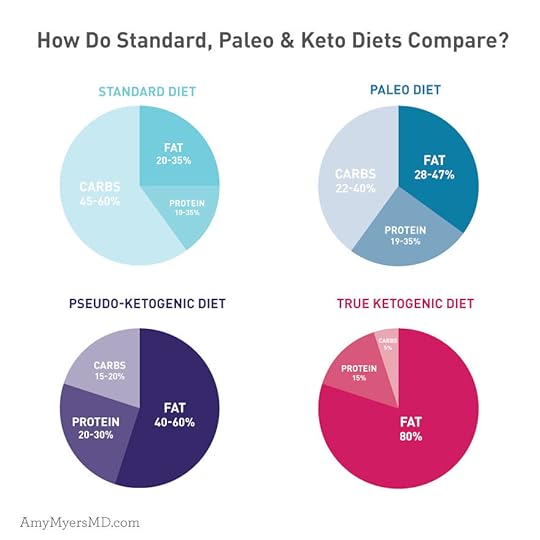
Standard diet:
45-60% carbohydrates (225-325g/day)
20-35% fat
10-35% protein
Paleo:
22-40% carbohydrates (110-200g/day)
28-47% fat
19-35% protein
Pseudo-ketogenic:
15-20% carbohydrates (30-50g/day)
40-60% fat
20-30% protein
Keto:
5% carbohydrates (20-30g/day)
80% fat
15% protein
As you can see, true keto diets contain far fewer carbs than standard diets or even Paleo diets, and the majority of your daily caloric intake will be from fatty foods. This puts your body into a state known as “ketosis” where it burns stored fat for fuel, rather than relying on glucose from carbs as its main energy source. It takes more calories to change fat into energy than it does carbs, and in ketosis you’re dipping into your own fat stores for energy. These two factors combined make keto diets an excellent tool for weight loss.1
Keto diets have also been used historically as a treatment for epilepsy, and may have potential benefits for diabetes, Alzheimer’s, cancer, and other diseases caused by chronic inflammation.23
Typically, a keto diet focuses on such foods as:
Meat
Eggs
Fatty fish
Butter or cream
Cheese
Milk or yogurt
Nuts and seeds
Healthy oils (including olive, coconut, and avocado oils)
Avocados
Low-carb veggies (green veggies, tomatoes, onions, peppers, etc.)4
You might be looking at this list and thinking, “I can’t eat any of that!” Don’t panic just yet! If you have an autoimmune disease, simply swapping out the foods you CAN’T eat for a few easy, healthful, and equally delicious substitutes will ensure your keto diet fits in seamlessly with your Autoimmune Solution Protocol.
Making Your Keto Diet Autoimmune-Friendly
Much of what you would eat on a typical keto diet is already AIP. For example, you can eat plenty of grass-fed meat, fatty fish such as wild salmon, healthy oils, avocados, and low-carb veggies on an autoimmune-friendly keto diet. Plus, did you know I already carry two products in my store that are already keto-approved? My Paleo Protein and Collagen Protein are low- and no-carb sources of clean protein that you can seamlessly add into your daily routine.
In addition, many of the foods that you would avoid on a keto diet you are already avoiding by following an autoimmune-friendly diet! This will give you a head start when making the switch to keto. Use the following guidelines to make your keto diet AIP-friendly.
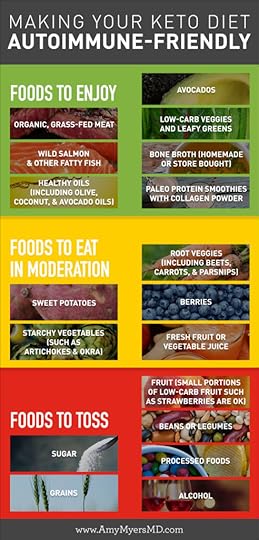
Foods to Enjoy:
Organic, grass-fed meat
Wild salmon and other fatty fish
Healthy oils (including olive, coconut, and avocado oils)
Avocados
Low-carb veggies and leafy greens
Bone broth (homemade or store bought)
Paleo Protein smoothies with Collagen Powder (see recipes)
Foods to Eat in Moderation:
Sweet potatoes
Starchy vegetables (such as artichokes and okra)
Root veggies (including beets, carrots, and parsnips)
Berries
Fresh fruit or vegetable juice (limit to 8 oz./day)
Foods to Toss:
Sugar
Grains
Fruit (small portions of low-carb fruit such as strawberries are okay)
Beans or legumes
Processed foods
Alcohol
The biggest challenge will be finding appropriate food swaps for keto staples such as dairy, nuts, seeds, eggs, and nightshades. You want to ensure your replacement foods are full of healthy fats, nutrients, and moderate amounts of protein, while still being low-carb. Use the list below for some food swap ideas to get you started.
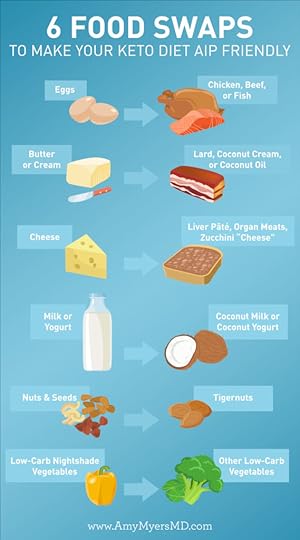
Foods to Swap:
Swap out: Eggs
Swap in: Chicken, beef, or fish; For baking: 1 Tbsp gelatin dissolved in 3 Tbsp warm water
Swap out: Butter or cream
Swap in: Coconut oil, coconut manna, or coconut cream; lard
Swap out: Cheese
Swap in: Organ meats (such as liver pâté); zucchini “cheese”
Swap out: Milk or yogurt
Swap in: Full-fat coconut milk or coconut yogurt
Swap out: Nuts and seeds
Swap in: Tigernuts
Swap out: Low-carb nightshade vegetables (tomatoes, peppers, etc.)
Swap in: Any other low-carb veggies including broccoli, asparagus, cauliflower, leafy greens, celery, and cucumbers
The most important part of transitioning to a keto diet–or any new diet, for that matter–is listening to your body. I personally did not do well on a keto diet, and have found that many of my patients who are women or who have thyroid dysfunction do not tolerate it either, due to hormone imbalances or adrenal fatigue. If you find you do not tolerate keto, don’t try to stick it out just because it’s the latest craze.
Otherwise, feel free to experiment with keto alongside the Autoimmune Solution Protocol and see what works best for you. And be sure to check out The Autoimmune Solution Cookbook for over 150 delicious, nutrient-dense AIP recipes that can be easily adapted to fit your keto diet!
The post How to Make a Keto Diet AIP Friendly appeared first on Amy Myers MD.
Amy Myers's Blog
- Amy Myers's profile
- 74 followers



